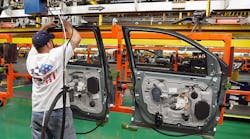U.S. manufacturers flexed plenty of muscle in October.
Almost all of the latest regional data, industry figures and government reports boasted momentum in the nation’s industrial sector, and it’s probably poised to continue at least through the end of the year.
While the recovery efforts from hurricanes Harvey and Irma are undoubtedly helping propel business activity, sturdy domestic sales and improving international demand represent solid pillars. Orders have piled up and caused backlogs to mount, indicating a boost in production that will drive the economy. These are all reasons why factories have been beefing up their workforces.
The Institute for Supply Management’s latest account of October showed a factory purchasing managers’ index hovering near a 13-year high, with 16 of 18 industries indicating growth. Comments in the report pointed to firm orders in the wake of recoveries in hurricane-affected parts of the country. But activity was also stronger excluding the rebound from the storms.
The ISM’s national report last week was foreshadowed by robust regional data.
The MNI Chicago Business Barometer, which also includes service providers, unexpectedly advanced to the highest level since March 2011. The Federal Reserve Bank of Dallas’ manufacturing gauge was the firmest in more than 11 years, the Kansas City Fed’s measure advanced to the strongest reading since March 2011 and the New York Fed’s index climbed to a three-year high.
Factory bookings are running ahead of inventories and production, as unfilled orders remain elevated. A ratio of the ISM’s factory orders gauge and its measure of inventories, a proxy of demand, stands at the second-highest level since 2010.
Firmer business investment in the U.S. and steady demand from overseas customers are also providing a more stable environment for American producers. The latest purchasing managers’ index from IHS Markit rose in October to the second-highest level since 2015.
“New business received by manufacturers increased solidly,” IHS Markit said in a statement. “Demand from foreign clients was also substantial, reflected in the quickest rise in export orders since August 2016.”
Government data show the actual pace of capital equipment orders and shipments has been powering ahead. Those bookings increased at an annualized pace of 12.4% in the three months through September, while sales improved 11.4% — the best performance since 2014.
Backlogs have been building as well, largely due to a surge in demand from rebuilding efforts after the tropical storms in late August and early September. The Commerce Department’s tally of unfilled orders for construction materials was up 7.6% in the 12 months through September, the biggest advance since 2011.
To help meet demand and alleviate growing order backlogs, manufacturers are bolstering assembly lines. The government’s latest jobs report showed factories have taken on 74,000 workers in the past three months, the most in four years. At nearly 12.5 million, manufacturing payrolls are the highest since January 2009.
Meanwhile, a 0.8% jump in aggregate weekly hours of employees in manufacturing, which measures employment and hours worked, was the largest in Labor Department data since March 2014. That could signal a jump in manufacturing output for October when the Fed reports its industrial production figures on Nov. 16.
By Vince Golle




